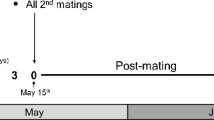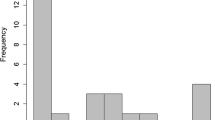Abstract
In birds, the number of sperm trapped between the perivitelline membranes around the ovum is an estimate of sperm numbers present at the time and place of fertilisation in the female reproductive tract. Sperm numbers may vary among species and between eggs in a clutch and can provide information about sperm utilisation and mechanisms of sperm competition. Here, we describe patterns of variation in sperm numbers through the egg-laying sequence in three passerines in which extra-pair paternity is common, but copulation behaviour differs. Sperm numbers showed no systematic change across the laying sequence in blue tits (Cyanistes caeruleus), but decreased significantly with laying order in bluethroat (Luscinia svecica) and tree swallow (Tachycineta bicolor) clutches. This is consistent with observations that blue tits regularly copulate throughout the laying sequence, while bluethroats stop mate guarding and tree swallows reduce their copulation frequency once the first egg is laid. Nevertheless, cases of a sudden increase in sperm numbers in clutches of bluethroats and tree swallows suggest that successful inseminations also occurred after laying started. In blue tits and bluethroats, sperm numbers were not higher on extra-pair sired eggs than on eggs sired by the social male, suggesting that extra-pair copulations are not timed to the period of peak fertility for each egg. More extra-pair offspring originated from eggs laid early in the sequence in blue tits, while there was no systematic bias in bluethroats. Our results suggest that copulations during the laying sequence are predominantly performed by within-pair males in our study species.


Similar content being viewed by others
References
Barber CA, Robertson RJ (2007) Timing of copulations and the pattern of paternity in relation to laying order in tree swallows Tachycineta bicolor. J Avian Biol 38:249–254
Birkhead TR, Biggins JD (1998) Sperm competition mechansims in birds: models and data. Behav Ecol 9:253–287
Birkhead TR, Fletcher F (1995) Depletion determines sperm number in male zebra finches. Anim Behav 49:451–456
Birkhead TR, Møller AP (1992) Sperm competition in birds: evolutionary causes and consequences. Academic, London
Birkhead TR, Petrie M (1995) Ejaculate features and sperm utilization in peafowl Pavo cristatus. Proc R Soc Lond B 261:153–158
Birkhead TR, Pellatt EJ, Fletcher F (1993) Selection and utilization of spermatozoa in the reproductive tract of the female zebra finch Taeniopygia guttata. J Reprod Fertil 99:593–600
Birkhead TR, Sheldon BC, Fletcher F (1994) A comparative study of sperm–egg interactions in birds. J Reprod Fertil 101:353–361
Birkhead TR, Wishart GJ, Biggins JD (1995) Sperm precedence in the domestic fowl. Proc R Soc Lond B 261:285–292
Charmantier A, Blondel J (2003) A contrast in extra-pair paternity levels on mainland and island populations of mediterranean blue tits. Ethology 109:351–363
Crowe SA, Kleven O, Delmore KE, Laskemoen T, Nocera JJ, Lifjeld JT, Robertson RJ (2009) Paternity assurance through frequent copulations in a wild passerine with intense sperm competition. Anim Behav 77:183–187
Delhey K, Johnsen A, Peters A, Andersson S, Kempenaers B (2003) Paternity analysis reveals opposing selection pressures on crown colouration in the blue tit (Parus caeruleus). Proc R Soc Lond B 270:2057–2063
Delhey K, Peters A, Johnsen A, Kempenaers B (2007) Fertilization success and UV ornamentation in blue tits Cyanistes caeruleus: correlational and experimental evidence. Behav Ecol 18:399–409
Denk AG, Holzmann A, Peters A, Vermeirssen ELM, Kempenaers B (2005) Paternity in mallards: effects of sperm quality and female sperm selection for inbreeding avoidance. Behav Ecol 16:825–833
Double MC, Dawson D, Burke T, Cockburn A (1997) Finding the fathers in the least faithful bird: a microsatellite-based genotyping system for the superb fairy-wren Malurus cyaneus. Mol Ecol 6:691–693
Dunn P, Robertson R, Michaud-Freeman D, Boag P (1994) Extra-pair paternity in tree swallows: why do females mate with more than one male? Behav Ecol Sociobiol 35:273–281
Eberhard WG (1996) Female control: sexual selection by cryptic female choice. Princeton Univ. Press, Princeton, NJ
Foerster K, Delhey K, Johnsen A, Lifjeld JT, Kempenaers B (2003) Females increase offspring heterozygosity and fitness through extra-pair matings. Nature 425:714–717
Fossøy F, Johnsen A, Lifjeld JT (2006) Evidence of obligate female promiscuity in a socially monogamous passerine. Behav Ecol Sociobiol 60:255–259
Fossøy F, Johnsen A, Lifjeld JT (2008) Multiple genetic benefits of promiscuity in a socially monogamous passerine. Evolution 62:145–156
Froman DP, Pizzari T, Feltmann AJ, Castillo-Juarez H, Birkhead T (2002) Sperm mobility: mechanisms of fertilizing efficiency, genetic variation and phenotypic relationship with male status in the domestic fowl, Gallus gallus domesticus. Proc R Soc Lond B 269:607–612
Griffith SC, Owens IPF, Thuman KA (2002) Extra-pair paternity in birds: a review of interspecific variation and adaptive function. Mol Ecol 11:2195–2212
Johnsen A, Lifjeld JT (2003) Ecological constraints on extra-pair paternity in the bluethroat. Oecologia 136:476–483
Johnsen A, Andersen V, Sunding C, Lifjeld JT (2000) Female bluethroats enhance offspring immunocompetence through extra-pair copulations. Nature 406:296–299
Johnsen A, Pärn H, Fossøy F, Kleven O, Laskemoen T, Lifjeld J (2008) Is female promiscuity constrained by the presence of her social mate? An experiment with bluethroats Luscinia svecica. Behav Ecol Sociobiol 62:1761–1767
Kempenaers B, Verheyen GR, Van den Broeck M, Burke T, Van Broeckhoven C, Dhondt AA (1992) Extra-pair paternity results from female preference for high-quality males in the blue tit. Nature 357:494–496
Kleven O, Fossøy F, Laskemoen T, Robertson RJ, Rudolfsen G, Lifjeld JT (2009) Comparative evidence for the evolution of sperm swimming speed by sperm competition and female sperm storage duration in passerine birds. Evolution 63:2466–2473
Krist M, Nadvornik P, Uvirova L, Bures S (2005) Paternity covaries with laying and hatching order in the collared flycatcher Ficedula albicollis. Behav Ecol Sociobiol 59:6–11
Krokene C, Lifjeld JT (2000) Variation in the frequency of extra-pair paternity in birds: a comparison of an island and a mainland population of blue tits. Behaviour 137:1317–1330
Krokene C, Anthonisen K, Lifjeld JT, Amundsen T (1996) Paternity and paternity assurance behaviour in the bluethroat, Luscinia s. svecica. Anim Behav 52:405–417
Krokene C, Rigstad K, Dale M, Lifjeld JT (1998) The function of extrapair paternity in blue tits and great tits: good genes or fertility insurance? Behav Ecol 9:649–656
Lifjeld JT, Dunn PO, Robertson RJ, Boag PT (1993) Extra-pair paternity in monogamous tree swallows. Anim Behav 45:213–229
Lifjeld JT, Aas CK, Birkhead TR, Fletcher F, Krokene C, Rigstad K (2000) Variation in number of spermatozoa in blue tit and great tit eggs. Auk 117:246–249
Lifjeld JT, Johnsen A, Petitguyot T (2005) Egg-size variation in the bluethroat (Luscinia s. svecica): constraints and adaptation. J Ornithol 146:249–256
Magrath MJL, Vedder O, van der Velde M, Komdeur J (2009) Maternal effects contribute to the superior performance of extra-pair offspring. Curr Biol 19:792–797
Michl G, Török J, Griffith SC, Sheldon BC (2002) Experimental analysis of sperm competition mechanisms in a wild bird population. Proc Natl Acad Sci USA 99:5466–5470
Pizzari T, Cornwallis CK, Løvlie H, Jakobsson S, Birkhead TR (2003) Sophisticated sperm allocation in male fowl. Nature 426:70–74
Pryke SR, Rollins LA, Griffith SC (2010) Females use multiple mating and genetically loaded sperm competition to target compatible genes. Science 329:964–967
Questiau S, Eybert M-C, Taberlet P (1999) Amplified fragment length polymorphism (AFLP) markers reveal extra-pair parentage in a bird species, the bluethroat (Luscinia svecica). Mol Ecol 8:1331–1339
Riley HT, Bryant DM, Carter RE, Parkin DT (1995) Extra-pair fertilizations and paternity defence in house martins, Delichon urbica. Anim Behav 49:495–509
Rudolfsen G, Figenschou L, Folstad I, Nordeide JT, Soreng E (2005) Potential fitness benefits from mate selection in the Atlantic cod (Gadus morhua). J Evol Biol 18:172–179
Schielzeth H (2010) Simple means to improve the interpretability of regression coefficients. Methods Ecol Evol 1:103–113
Small AO, Schlusser K, Ryan CJ, Jamieson IG (2000) Detecting sperm on the perivitelline membrane of incubated turkey eggs and its implications for research on fertility problems in endangered species. Wildlife Res 27:635–637
Stapleton MK, Robertson RJ (2006) Female tree swallow home-range movements during their fertile period as revealed by radio-tracking. Wilson J Ornithol 118:502–507
Stapleton MK, Kleven O, Lifjeld JT, Robertson RJ (2007) Female tree swallows (Tachycineta bicolor) increase offspring heterozygosity through extrapair mating. Behav Ecol Sociobiol 61:1725–1733
Vedder O, Magrath MJL, Harts AMF, Schut E, van der Velde M, Komdeur J (2010) Reduced extrapair paternity in response to experimental stimulation of earlier incubation onset in blue tits. Behav Ecol 21:9–15
Venier LA, Robertson RJ (1991) Copulation behaviour of the tree swallow, Tachycineta bicolor: paternity assurance in the presence of sperm competition. Anim Behav 42:939–948
Wishart GJ (1987) Regulation of the length of the fertile period in the domestic fowl by numbers of oviductal spermatozoa, as reflected by those trapped in laid eggs. J Reprod Fertil 80:493–498
Acknowledgments
We thank Cheryl Bishop, Frode Fossøy, Karin Hieke, Terje Laskemoen, Anne Peters, Thomas Petitguyot, Angelika Poesel, Agnes Tuerk, Emmi Schlicht and Mihai Valcu for assistance in the field, and Frode Fossøy for lab assistance. We are grateful to Raphael-Thomas Klumpp and Alfred Fojt from the Institute of Silviculture, Vienna, for providing access to their facilities, to Hans Winkler from the Konrad Lorenz Institute for Comparative Ethology, Vienna, for logistical support, to the staff at the Queen’s University Biological Station for facilities and logistical support, and to Chris Eckert at Queens’ University for letting us use his microscopy laboratory. BK designed the study; KC and BK conducted the blue tit field work; AJ, KC, KD, JTL and BK conducted the bluethroat fieldwork; KC, RJR and BK conducted the tree swallow fieldwork; KC and BK counted the sperm on the egg membranes; KC conducted the blue tit paternity analysis, AJ conducted the bluethroat paternity analysis; AJ and BK analysed the data; AJ wrote the paper in collaboration with all other co-authors. We thank Jim Briskie and two anonymous reviewers for thoughtful comments on the manuscript. The work was funded by the Max Planck Society, the Norwegian research Council, the Natural History Museum of the University of Oslo, and the Natural Sciences and Engineering Research Council of Canada.
Ethical standards
The work described here was done under license and complied with the current laws of the countries in which it was performed.
Conflicts of interest
None
Author information
Authors and Affiliations
Corresponding author
Additional information
Communicated by J. Graves
Electronic supplementary material
Rights and permissions
About this article
Cite this article
Johnsen, A., Carter, K.L., Delhey, K. et al. Laying-order effects on sperm numbers and on paternity: comparing three passerine birds with different life histories. Behav Ecol Sociobiol 66, 181–190 (2012). https://doi.org/10.1007/s00265-011-1265-4
Received:
Revised:
Accepted:
Published:
Issue Date:
DOI: https://doi.org/10.1007/s00265-011-1265-4




